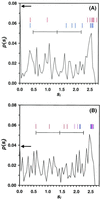Computational method to reduce the search space for directed protein evolution
- PMID: 11274394
- PMCID: PMC31129
- DOI: 10.1073/pnas.051614498
Computational method to reduce the search space for directed protein evolution
Abstract
We introduce a computational method to optimize the in vitro evolution of proteins. Simulating evolution with a simple model that statistically describes the fitness landscape, we find that beneficial mutations tend to occur at amino acid positions that are tolerant to substitutions, in the limit of small libraries and low mutation rates. We transform this observation into a design strategy by applying mean-field theory to a structure-based computational model to calculate each residue's structural tolerance. Thermostabilizing and activity-increasing mutations accumulated during the experimental directed evolution of subtilisin E and T4 lysozyme are strongly directed to sites identified by using this computational approach. This method can be used to predict positions where mutations are likely to lead to improvement of specific protein properties.
Figures




References
-
- Moore J C, Arnold F H. Nat Biotechnol. 1996;14:458–467. - PubMed
-
- Miyazaki K, Wintrode P, Grayling R, Rubingh D, Arnold F H. J Mol Biol. 2000;297:1015–1026. - PubMed
-
- Street A G, Mayo S L. Structure (London) 1999;7:R105–R109. - PubMed
-
- Dahiyat B I, Mayo S L. Science. 1997;278:82–87. - PubMed
-
- Malakaukas S M, Mayo S L. Nat Struct Biol. 1998;5:470–475. - PubMed
Publication types
MeSH terms
Substances
LinkOut - more resources
Full Text Sources
Other Literature Sources

